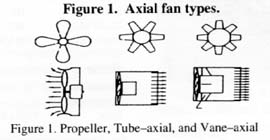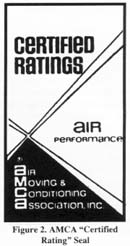
Glen J. Arnold
Michael A. Veenhuizen
Livestock producers often purchase ventilation equipment direct from the manufacturer to reduce costs. When building new facilities or completing a major building renovation a livestock producer may purchase thousands of dollars of ventilation equipment. Many items should be considered when making such selections.
Ventilation is an air exchange process that brings fresh air into a building, thoroughly mixes the air, and exhausts moist contaminated air from the building.
A properly designed and installed ventilation system is more than just a fan. It includes air inlets, outlets, and controls. The fan is the "heart" of a mechanical ventilation system that provides the driving force for the needed air exchange in livestock facilities.
Fans are used to force air in to, pull air out of, or circulate air inside livestock buildings. Energy (electricity) is required to operate fans. To most efficiently use the energy inputs and achieve desirable results, all components of ventilation system must be carefully designed, selected, installed, and managed.
When selecting ventilation fans, consider:
Some of these factors, such as service and support, depend on location and availability of local suppliers. Others, such as cost, durability, and suitability are subjective evaluations and must be considered on a case by case basis. Factors such as fan type, ventilation capacity, quantity of air delivered, static pressure, and energy efficiency can be quantitatively measured and reported. All are important criteria for selecting a fan or group of fans.
Fans can be axial flow or centrifugal. Axial fans are most commonly used in livestock buildings. Centrifugal fans are often utilized where inflatable curtains or ridge-closing bladders are found.
Fans can be axial flow or centrifugal. Axial flow fans pass air straight through the fan parallel to the fan blade drive shaft. Centrifugal fans (squirrel cage fans) bring air in through a center inlet, the air makes a right angle turn and is discharged perpendicular to the fan axis.
Axial flow fans are designed to operate at low static pressures (typically less than 0.5 inches of water column). They are commonly used for livestock building ventilation. The initial cost is less and performance is influenced less by dirt buildup on the fan blades.

Propeller fans have propeller-shaped blades mounted in a circular ring or orifice plate and a drive motor. Propeller fans scoop air and move it away from the fan blade. Blade tip clearance is an important factor in fan performance. A small, uniform clearance is preferred to prevent air from flowing back around the propeller. These fans move large volumes of air at low static pressure. Propeller fans are typically 6" to 72" in diameter. They are designed to operate at static pressures of 0" to 0.5" of water column.
Another type of propeller fan is the circulation fan used to help improve air distribution, reduce temperature stratification, increase air velocity in the animal zone, and eliminate dead air spots. Circulation fans usually operate at zero to low static pressure. Paddle fans mounted to the ceiling are an effective method to circulate large volumes of air against zero or low static pressure.
Tube-axial fans consist of a tube-shaped housing, a propeller-shaped blade, and a drive motor. Tube-axial fans can operate at higher static pressure because of a larger hub and reduced blade tip clearance, so less air flows back through the fan. Tube- axial are typically used in low and medium pressure duct air distribution systems. A rapidly growing use for this fan is manure pit ventilation. They are typically 12" to 48" in diameter and operate at static pressures as high as 3.5 inches of water column.
Vane-axial fans similar in design and application to tubeaxial fans. The major difference is that air straightening vanes are added either in front of or behind the blades to reduce the circular motion of the air. This results in a more efficient fan capable of operating at a slightly higher static pressure. Typical uses are grain drying, aeration, and sometimes pressure duct air distribution.
Centrifugal fans are quieter and can operate at much higher static pressures than axial flow fans. Centrifugal fans operate by throwing air away from the fan blade tips. These blades can be forward curved, straight, or backward curved. Centrifugal fans should be used for handling relatively clean air because dirt accumulation on centrifugal fan blades affects efficiency and airflow capacity. Centrifugal fans are commonly used in grain drying and forced air heating systems where high static pressures are required.
A ventilating system is used to control the environment. Ventilation capacity is based primarily on the amount of air exchange needed to remove moisture in the winter and excess heat in the summer. Airflow requirements vary with animal size and outside weather conditions. Ideally, ventilation air must vary from just enough air to maintain good air quality during very cold weather up to a maximum rate to eliminate heat stress during hot weather.
A properly sized ventilation system should provide at least three seasonal ventilation rates---cold, mild, and hot weather.
Cold weather ventilation is the minimum continuous rate that provides enough air to remove excess moisture. Cold weather fans run continuously with an emergency shut-off thermostat. Mild weather ventilation increases the air exchange rate to modify temperature and remove moisture. Mild weather fans are typically turned on and off with thermostats to maintain a desired air temperature. Hot weather ventilation reduces heat build-up and increases air movement past the animals. Table I gives recommended ventilating rates for several livestock types.
| Table 1. Recommended Ventilation Rates | ||||||
|---|---|---|---|---|---|---|
| Animal | Weight | Unit | Cold | Mild | Hot | |
| Weather | ||||||
| Rate | Rate | Rate | ||||
| lbs. | CFM/Unit | |||||
| Swine | ||||||
| Sow & Litter | 400 | HD | 20 | 80 | 500 | |
| PRENURSERY PIG | 12-30 | HD | 2 | 10 | 25 | |
| NURSERY PIG | 30-75 | HD | 3 | 15 | 35 | |
| GROWING PIG | 75-150 | HD | 7 | 24 | 75 | |
| FINISHING PIG | 150-220 | HD | 10 | 35 | 120 | |
| GESTATING PIG | 325 | HD | 12 | 40 | 150 | |
| Boar/Breeding | ||||||
| sow | 400 | HD | 14 | 50 | 300 | |
| Beef | ||||||
| 0-2 MO | HD | 15 | 50 | 100 | ||
| 2-12 MO | HD | 20 | 60 | 130 | ||
| 12-24 MO | HD | 30 | 80 | 180 | ||
| Mature Cow | 1000lbs. | 36 | 120 | 335 | ||
| Veal Calf | ||||||
| 100 LB | 10 | 20 | 50 | |||
| Dairy | ||||||
| 0-2 MO | HD | 15 | so | 100 | ||
| 2-12 MO | HD | 20 | 60 | 130 | ||
| 12-24 MO | HD | 30 | 80 | 180 | ||
| Mature Cow | 1000 LB | 36 | 120 | 335 | ||
| Horse | ||||||
| Controlled Environment Barn |
1000 LB | 25 | 100 | 335 | ||
| Poultry | ||||||
| Broiler 0-7 Days | HD | 0.04 | 0.5 | 1.0 | ||
| Broiler Over 7 Day | LB | 0.1 | 0.5 | 1.0 | ||
| Layers | LB | 0.1 | 0.5 | 1-1.5 | ||
| Turkeys | ||||||
| Poults | HD | 0.2 | 0.7 | 1-4 | ||
| Growers | LB | 0.08 | 0.35 | 0.8 | ||
| Breeders 20-30 | LB | 0.05 | 0.15 | 0.5 | ||
| Rabbits | ||||||
| LB | 0.1 | 0.5 | 1.0 | |||
| Sheep | ||||||
| Controlled Environment Barn |
1000 | LB | 25 | 100 | 335 | |
Fan capacity is measured as the volume of air (cubic feet) moved per unit of time (minute). It is usually expressed as cubic feet per minute (cfm).
The amount air a fan moves depends on the blade diameter, blade shape, fan speed (revolutions per minute, rpm), motor horsepower, and housing. Two most common measurements used to describe the characteristics of a fan are blade diameter and motor horsepower.
These are useful measurements but without performance characteristics (airflow and static pressure), these are only very general indicators of fan capacity. A comparison test of 39 commercially available thirty-six inch diameter fans operated at 0. 1 inches static pressure showed that air delivery varied from 6,400 to 10,000 cfm. Such large variations in capacity for similar fans provide clear evidence that fans should not be purchased or evaluated strictly by the fan blade diameter.
Where unvented heaters are used, provide at least an additional 2 1/2 cfm continuous ventilating capacity per 1,000 BTU/ hr of heater capacity.
If mechanical, earth tempered, or wet-skin cooling is provided for mature animals, the hot weather rate may be reduced. See MWPS-34 Heating, Cooling, and Tempering Air for Livestock Housing, for design information about heating and cooling systems.
400 cfm/1,000 lb cow is recommended in the mid-Atlantic and southeast states.
Static pressure is the pressure that a fan is capable of developing. Static pressure is also a measure of the resistance to airflow or the pressure developed as a given rate of airflow moves through system. Static pressure is usually expressed as inches of water column.
Static pressure or air pressure difference is usually measured between the inside and outside of a building with a manometer and is expressed in inches of water column.
Resistance to airflow occurs throughout the entire ventilation system. In a mechanically ventilated barn, the exterior air inlets, baffled slot inlets, building space, fan safety guard, fan housing, louvered shutters, and exterior weather hood all contribute to the system's resistance to airflow.
Typically, the system resistance is about 0. 1 to 0. 125 inches of water column. For this reason, ventilation fans are typically selected to deliver the desired airflow at 0.125 (1/8") static pressure. For any ventilation system, the resistance to airflow or static pressure increases at higher airflow rates.
When purchasing fans for livestock buildings be sure to request a fan performance chart from the manufacturer. The performance chart is needed to determine the airflow capacity in cubic feet per minute (cfm) at various static pressures. File this chart for future reference.
A fan's primary purpose is to move air. Therefore it is important to know how much air the fan can move, Many manufacturers have their fans rated by standard testing procedures certified by the Air Movement and Control Association (AMCA), an independent testing laboratory.
A recommended practice is to select fans bearing the AMCA "Certified Rating" seal, Figure 2. Fans with the AMCA seal are more certain to perform in accordance with the information printed in the manufacturer's literature.
Fan manufacturers can also use other procedures or testing laboratories that give valid results. An important consideration is to select fans to deliver the desired airflow (cfm) at 0. 10 to 0. 125 inches of static pressure.

Good quality fans are essential for proper performance of any mechanical ventilation system. Fans should be selected to deliver the required ventilation capacity for each season. Select fans on the basis of delivering a desired airflow against a static pressure of 0. 1 to 0. 125 inches of water for most ventilation applications. If higher static pressures are required, select fans based on the required values. Look for the AMCA certified rating seal or other reliable testing when purchasing fans to assure a valid rating. Make sure louvers, shutters, and other fan accessories are in place when selecting fans for required ventilation rates.